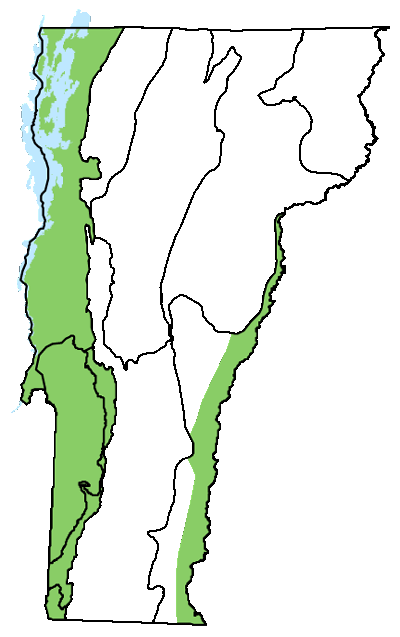Ecology and Physical Setting
Oak-Black Birch Talus Woodlands occur as small patches in warmer regions of the state and in warm settings with non-calcareous bedrock. They are typically found on south and southwest aspects. Rocks and boulders break off cliff faces over millennia and form talus slopes below. Soil accumulates between the steep, jumbled rocks and supports a woodland or forest depending on the amount of available soil. Open canopy woodlands are more likely to occur in areas with large boulders and little available soil. The physical character of the talus slope varies considerably with the type of bedrock. Quartzite and granite create slopes with large boulders that are relatively stable; slate and schist create more platy fragments that form relatively unstable slopes that are difficult and sometimes dangerous to traverse.
Although Oak-Black Birch Talus Woodland occurs on non-calcareous bedrock, the steep slopes are often enriched by colluvial processes (downslope movement of soils and nutrients) and the vegetation may reflect this enrichment. This is similar to finding a Rich Northern Hardwood Forest in a cove or toeslope where the bedrock is not calcareous.
Vegetation
Oak-Black Birch Talus Woodland typically has less than 60 percent canopy cover, but forests with more closed canopies occur on sites with better growing conditions, where more soil and moisture are available. Red oak is a prominent canopy component on most sites, with white oak present in the warmer settings. Black birch is not always abundant but is characteristic. Other trees include sugar maple and hophornbeam. Basswood and white ash are common associates and reflect the colluvial enrichment on these slopes. It is not uncommon to find large oaks and other tree species at the tops of talus slopes, just below the cliffs.
Shrubs can be abundant on the most open and rocky sites, but they become sparse with more closed canopies. Typical shrubs include witch hazel, maple-leaved viburnum, mountain maple, and red-berried elder. Vines of Virginia creeper and poison ivy sprawl over the rocks. Herb cover varies with moisture and light availability. Typical species include marginal wood fern, sarsaparilla, Canada mayflower, false Solomon’s seal, blue-stemmed goldenrod, and black-seeded mountain rice. Rock polypody covers many of the boulder tops. Enrichment indicators like pale jewelweed and broad-leaved sedge may be present in soil pockets, but only acid-tolerant herbs are found growing on the boulders.
Wildlife Habitat
The jumble of rocks and boulders on talus slopes creates ideal denning sites for bobcats and porcupines. Cavities in talus slopes provide overwintering sites for many snake species, including the common DeKay’s brownsnake and gartersnake, and the rare eastern ratsnake and timber rattlesnake. The exposed warm rocks are also important sunning areas for snakes.
Successional Trends
Succession can be dramatic. Falling rocks and slope instability cause rock slides, tree death, and root tip ups. Larger openings created by these events are colonized by early successional species. Because of difficult access for timber management, and little physical instability, some Oak-Black Birch Talus Woodlands have old forest characteristics.
Related Communities
- Northern Hardwood Talus Woodland is dominated by yellow birch, white ash, sugar maple, and other northern hardwood species. It lacks the warm-climate oaks.
- Oak-Maple Limestone Talus Woodland also has oaks and other warm-climate species but occurs on calcareous bedrock. Many calcium-loving herbs grow directly on the rock surfaces.
Conservation Status and Management Considerations
There are few examples of this uncommon natural community documented on conserved lands. Forest management is difficult due to the steep, rocky, and sometimes unstable slopes. Given their small size and importance for mammal and reptile denning sites, most Oak-Black Birch Talus Woodlands should be left to mature under natural processes.
Distribution/Abundance
This uncommon natural community is restricted to the warmer regions of Vermont.
Characteristic Plants
Trees
Abundant Species
Red oak – Quercus rubra
Occasional to Locally Abundant Species
White oak – Quercus alba
Black birch – Betula lenta
Sugar maple – Acer saccharum
Hophornbeam – Ostrya virginiana
White pine – Pinus strobus
Bitternut hickory – Carya cordiformis
Hackberry – Celtis occidentalis
Shrubs and Vines
Occasional to Locally Abundant Species
Witch hazel – Hamamelis virginiana
Maple-leaved viburnum – Viburnum acerifolium
Mountain maple – Acer spicatum
Red-berried elder – Sambucus racemosa
Virginia creeper – Parthenocissus quinquefolia
Poison ivy – Toxicodendron radicans
Prickly gooseberry – Ribes cynosbati
Red raspberry – Rubus idaeus
Purple-flowering raspberry – Rubus odoratus
Herbs
Occasional to Locally Abundant Species
Marginal wood fern – Dryopteris marginalis
Sarsaparilla – Aralia nudicaulis
Canada mayflower – Maianthemum canadense
False Solomon’s seal – Maianthemum racemosum
Blue-stemmed goldenrod – Solidago caesia
Black-seeded mountain rice – Patis racemosa
Rock polypody – Polypodium virginianum
Pale jewelweed – Impatiens pallida
Broad-leaved sedge – Carex platyphylla
Rare and Uncommon Plants
Annual false-foxglove – Aureolaria pedicularia
Drummond’s rock cress – Boechera stricta
Associated Animals
DeKay’s brownsnake – Storeria dekayi
Common gartersnake – Thamnophis sirtalis
Bobcat – Lynx rufus
Porcupine – Erethizon dorsatum
Eastern chipmunk – Tamias striatus
Rare and Uncommon Animals
Eastern ratsnake – Pantherophis alleghaniensis
Common five-lined skink – Plestiodon fasciatus
Timber rattlesnake – Crotalus horridus
Hackberry emperor – Asterocampa celtis
Tawny emperor – Asterocampa clyton
Places to Visit
Mount Moosalamoo, Salisbury, Green Mountain National Forest
Little Ascutney Wildlife Management Area, Weathersfield, Vermont Fish and Wildlife Department
